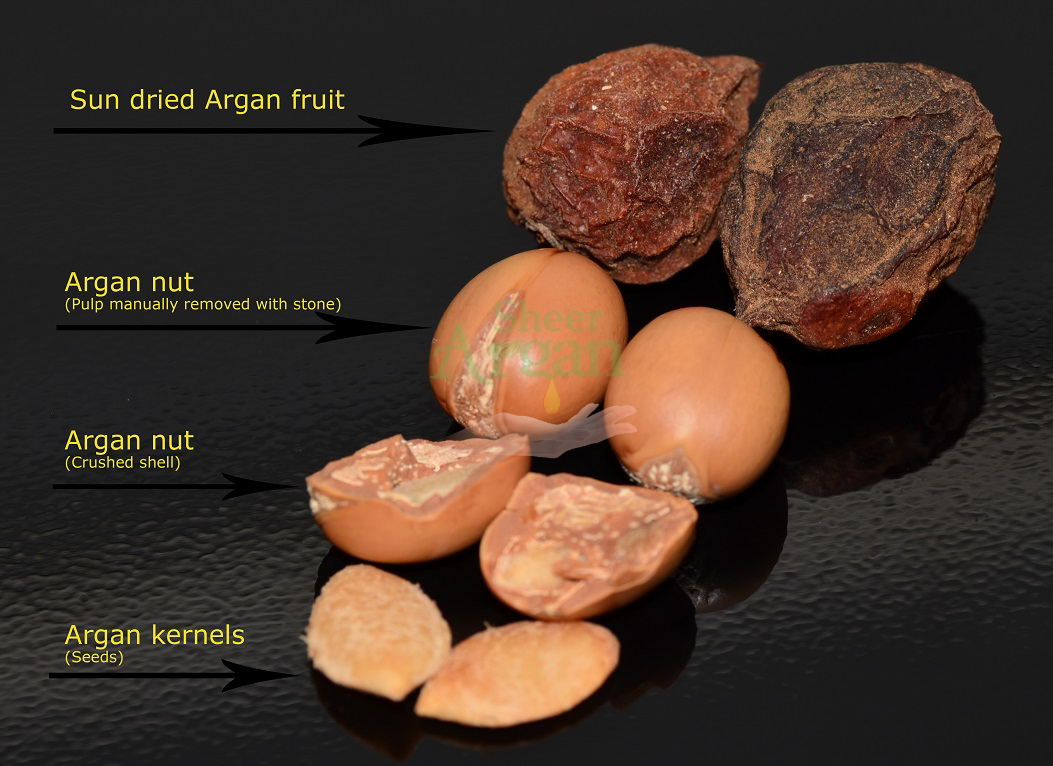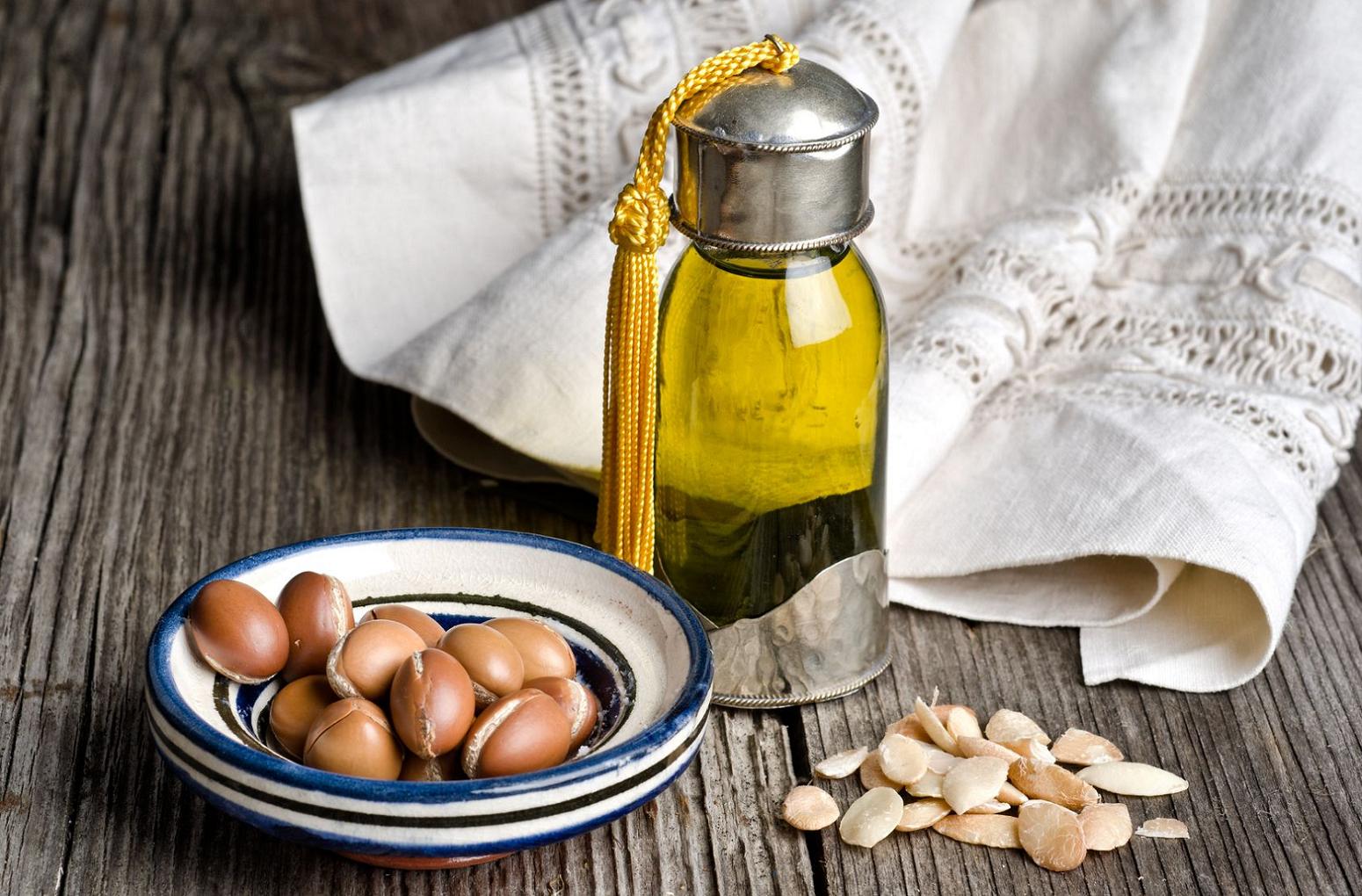Argan oil is a plant oil produced from the kernels of the argan tree. Argan oil contains vitamin E, phenols, carotenes, squalene, and fatty acids. Traditionally used as a treatment for skin conditions, including acne, Argan oil is full of vitamins and antioxidants, and also used in hair shampoos and conditioners to repair damage.
Argan Tree : Argania spinosa

The argan tree (Argania spinosa), is a species of tree endemic to Morocco, that is valued for its nutritive, cosmetic and numerous medicinal properties. It is also known in cosmetic use as moroccan oil.
The tree is extremely well adapted to drought and other environmentally harsh conditions of southwestern Morocco, it tree grows wild in semi-arid soil, its deep root system helping to protect against soil erosion and the northern advance of the Sahara. This biosphere reserve, the Arganeraie Biosphere Reserve, covers a vast intramontane plain of more than 2,560,000 hectares, bordered by the High Atlas and Little Atlas Mountains and the Atlantic in the west.
Argan oil remains one of the rarest oils in the world due to the small and very specific growing areas.
THE FRUITS OF THE ARGAN TREE

The fruits of the argan tree are nut-sizes and may be round, oval or conical in shape. The fruits are covered by a thick peel which covers the fleshy pulp. The pulp surrounds a hard-shelled nut which represents approximately 25% of the weight of the fresh fruit. Contained within the nut are one to three argan oil-rich kernels. Argan oil is extracted from the kernels, with yields varying from 30% to 55% depending on the extraction method used.
TRADITIONAL EXTRACTION METHOD


Before modern times, the Berbers of ancient Morocco would collect undigested argan pits from the waste of goats which climb the trees to eat their fruit. The pits were then ground and pressed to make the nutty oil used in cooking and cosmetics. However, the oil used in cosmetic and culinary products available for sale today has most likely been harvested directly from the tree and processed with machines. After pressing, the argan oil is decanted and left to rest for approximately two weeks. This allows solids suspended in the argan oil to settle to the bottom, creating a natural sediment. The clearer argan oil may then be further filtered depending on the clarity and degree of purity required. Pure argan oil may contain some sediment. This is a natural part of the production process and does not affect the quality of the argan oil.
PRESS-EXTRACTION METHOD

Now increasingly important for oil produced for sale, as the oil will keep 12 to 18 months and extraction is much faster. Using mechanical presses, mixing of the dough and water is unnecessary and the dough can be directly pressed. Extraction of the kernels is key to the argan oil production process. In order to extract the kernels, the argan fruits are first dried in the open air and then the fleshy pulp of the fruit is removed. Sometimes the flesh is removed mechanically without the need to dry the fruits. The flesh is usually used as feed for animals. The next stage involves cracking the argan nut to obtain the argan kernels. Kernels are used to make argan oil for food and cosmetic uses, culinary argan oil , are then gently roasted. After the argan kernels have cooled down, they are ground and pressed. The brown-colored mash expels pure, unfiltered argan oil. After this, unfiltered argan oil is decanted into vessels. The press cake remaining after the argan oil has been expelled is protein-rich and is frequently used as feed for cattle. After pressing, the argan oil is decanted and left to rest for approximately two weeks. This allows solids suspended in the argan oil to settle to the bottom, creating a natural sediment.
COSMETIC USES

Unroasted argan oil is traditionally used as a treatment for skin diseases and as a cosmetic oil for skin and hair: "In cosmetics, argan oil is advocated as moisturizing oil, against juvenile acne and flaking of the skin as well as for nourishing the hair. This oil has also medicinal uses against rheumatism and the healing of burns. Externally, argan oil is used for hair as brilliantine, to fortify and in the treatment of wrinkled or scaly dry skin". Argan oil has become increasingly popular for cosmetic use. The number of personal-care products on the US market with argan oil as an ingredient increased from just two in 2007 to over one hundred by 2011. It is sometimes mixed with pomegranate seed oil due to its antioxidizing benefits, with vendors promoting this blend as an all-in-one serum both for skin and hair. Argan oil is also sold without additives as a natural skincare and hair care product. The increasing popularity of argan oil has prompted the Moroccan government to plan for increased production: its aim is to triple annual production from approximately 2,500 to 4,000 tonnes by 2020.
ALIMENTRY USES

Culinary argan oil (argan food oil) is used for dipping bread, on couscous, salads and similar uses. Amlou, a thick brown paste with a consistency similar to peanut butter, is produced by grinding roasted almond and argan oil using stones, mixed with honey and is used locally as a bread dip. Various claims about the beneficial effects on health due to the consumption of argan oil have been made.
Argan oil contains a high level of oleic and linoleic acid and is also particularly rich in phenols. Since these metabolites are currently considered as essential to explain some of the protective effects against cancer and coronary heart disease attributed to other oils, similar effects can be expected from argan oil consumption as suggested by the amazigh medicine claims.
Interestingly, argan oil content in γ -tocopherol is much higher than that of any other oils. γ -Tocopherol has recently been shown to possess strong chemopreventive and anti-inflammatory properties. This indicates that argan oil should readily find a place of choice amid the most profitable oils for human health.



